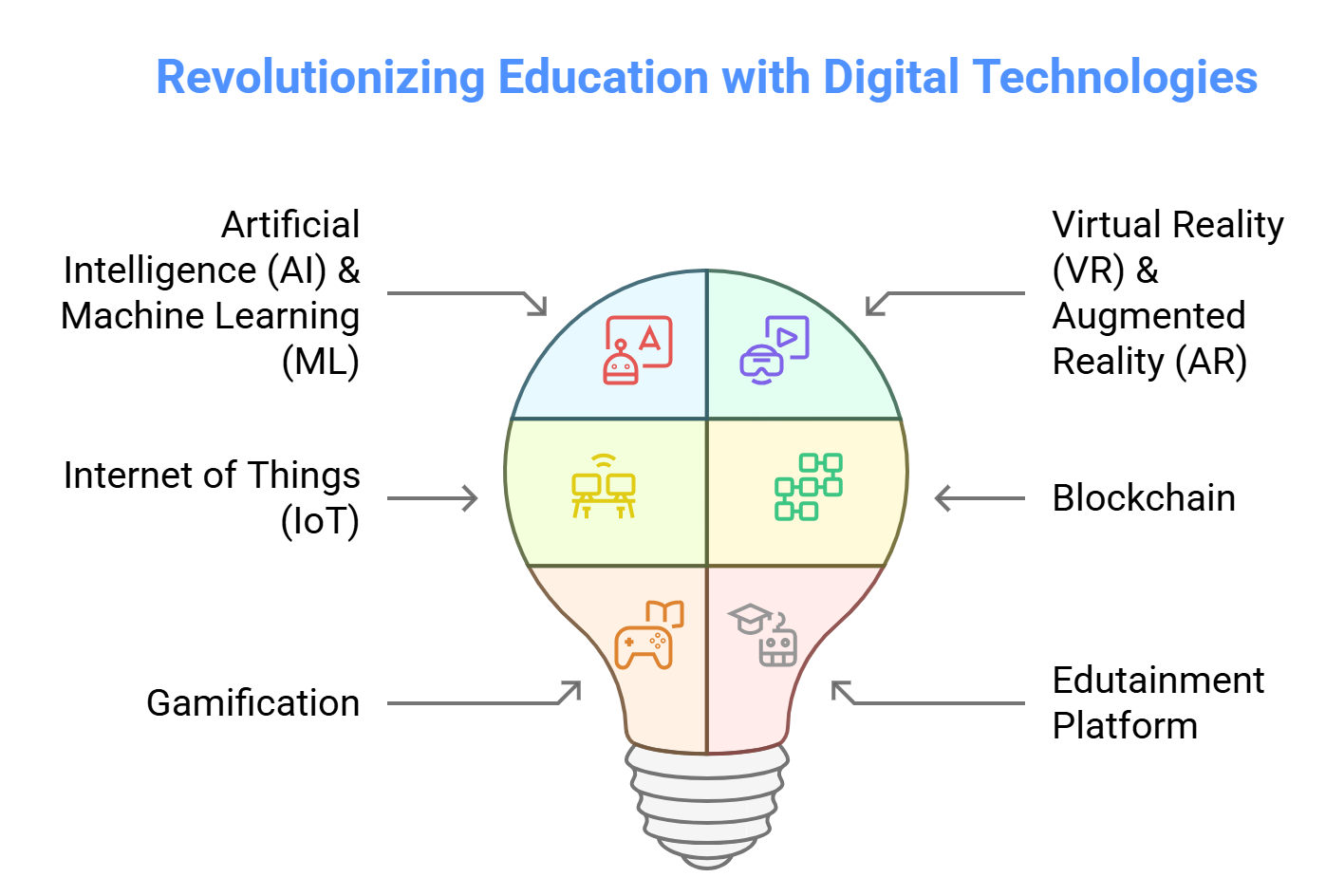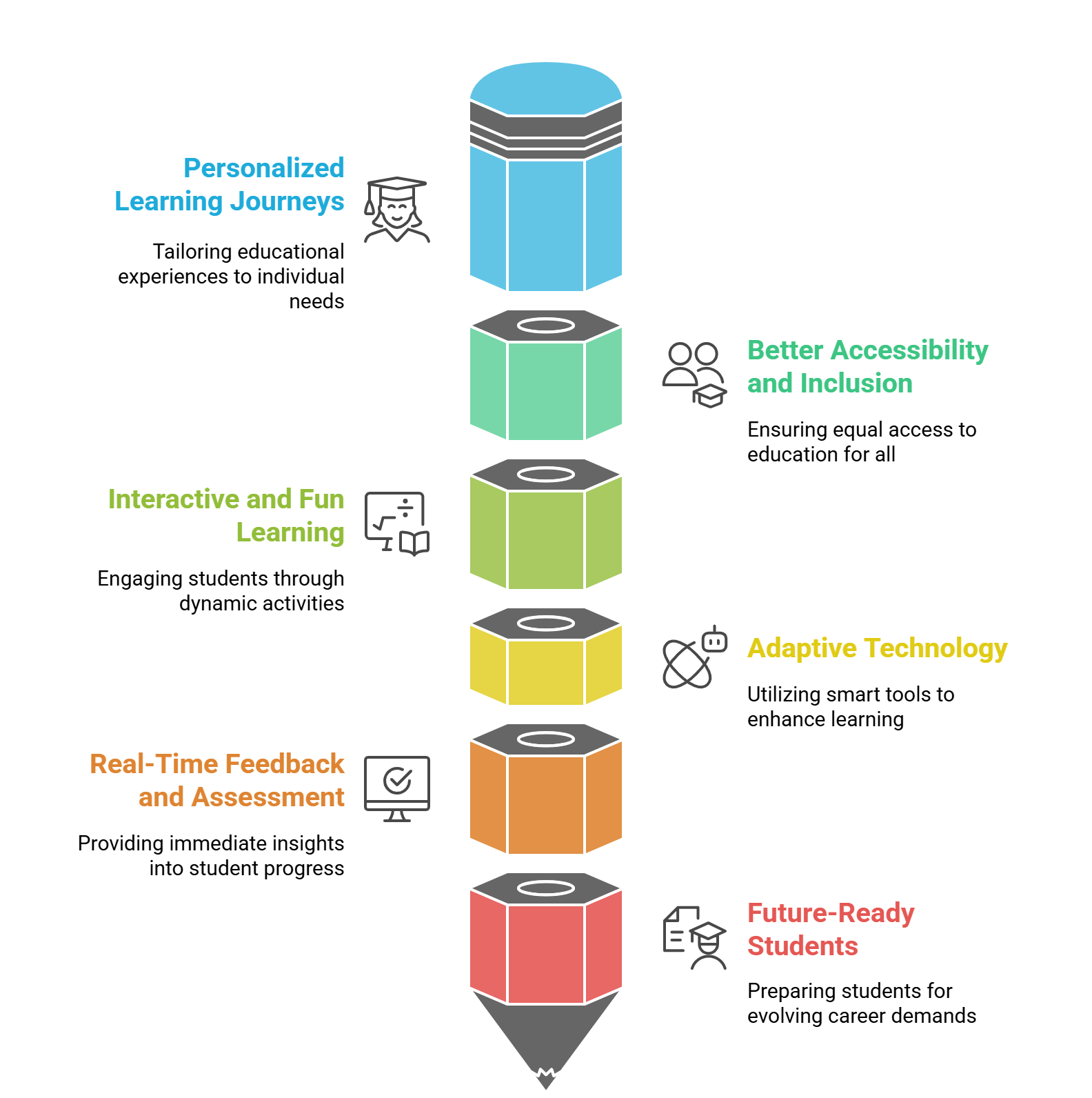Over the past few years, the education sector has experienced a major shift, and digital transformation redefines how knowledge is delivered and consumed. Valued as one of the fastest-growing segments in the digital economy, the global edTech and smart classroom market is experiencing rapid expansion. With digital transformation in education, traditional classrooms are evolving into dynamic hubs of innovation, blending AI, VR, mobile apps, and cloud tech to unlock new innovative ways of teaching and learning.
With over 90% of students now using digital tools, this evolution is accelerating rapidly. It’s driving a new era of learning, which is more personalized, inclusive, and adaptable, equipping learners everywhere with the skills they need to succeed in a digital future.
What is Digital Transformation in Education?
Digital transformation in education sector is the meaningful integration of modern digital technologies in teaching, learning, and school operations. It involves smart learning systems, immersive simulation technologies, mobile learning applications, and more, making education more personalized, engaging, and impactful for every student.
For example, a student finding math challenging can now turn to an AI-powered learning app that adapts to their pace and gives instant feedback. Another might explore ancient history through a virtual reality headset, stepping into recreations of historic cities.
At the same time, teachers benefit from interactive teaching platforms that let them monitor students’ progress in real time, while administrators streamline operations using cloud-based systems to handle everything from admissions to attendance more efficiently.
In short, digital transformation unites students, teachers, and institutions on a smarter, more connected journey. Therefore, learning is made more engaging, inclusive, and better equipped to meet the demands of today’s fast-moving digital world.
Why is Digital Transformation Important in Education?
Since technology is pervasive in today's world, digital transformation in education is essential for meeting the expectations and realities of the twenty-first century:
- Bridging the gap between technology and education: For education to remain relevant and effective, it must keep up with the rapid advancements in technology in daily life.
- Enhancing learning beyond the classroom: Learning can be done anywhere and at any time by using digital tools, overcoming the traditional constraints of time and place.
- Driving innovative teaching methods: Using technology in the classroom promotes new pedagogical approaches that help students become more creative and critical thinkers.
- Empowered teachers: Educators are given smarter tools to deliver content, track progress, and lessen administrative burdens so they may focus more on teaching.
Effective management: Cloud-based solutions streamline school management, enabling online platforms and mobile learning apps, whether it is remote, hybrid, or flipped classrooms.
Top Digital Transformation Technologies in Education

Artificial Intelligence (AI) & Machine Learning (ML):
Static learning environments become intelligent ecosystems thanks to AI and ML. It ensures that support is continuous and timely, whether it’s a chatbot answering student questions or an algorithm predicting who might need extra help,
Applications:
- Adaptive Learning
- Personalized learning paths
- AI Chatbots & Virtual Assistants
Automated grading and feedback
Virtual Reality (VR) & Augmented Reality (AR):
VR and AR transform student learning by providing life-like simulations and visual experiences that help in making lessons feel very real and engaging. These technologies allow students to explore environments and interact with objects that they normally could not access. In this way, they get hands-on learning in a safe and controlled virtual space.
Applications:
- Augmented reality in classrooms
- Virtual labs
Medical and technical training
Internet of Things (IoT):
IoT opens up new possibilities for education by connecting physical devices to the internet. It brings a new level of interactivity and automation to learning environments, meaning smarter campuses, automated processes, and interactive learning tools.
Applications:
- Smart classrooms
- Asset Management
Interactive learning devices
Blockchain:
Blockchain provides transparent and unchangeable record-keeping capabilities that can streamline many educational processes. It also plays a crucial role in managing academic credentials and student data, thereby building trust and efficiency between the institutions and students.
Applications:
- Secure credential verification
- Transparent admission and enrollment
Smart contracts for tuition and scholarships
Gamification:
Using game design elements to make learning feel less like a chore and more like an adventure, with elements including points, badges, challenges, and the leaderboard in educational settings, is called gamification. This boosts student engagement and improves retention.
Applications:
- Interactive quizzes and challenges
Collaborative learning
Edutainment Platform:
An edutainment platform blends education and entertainment to break down complex subjects through playful, relatable content that appeals to all ages and learning styles. This helps students find the motivation and curiosity to make every learning session both productive and enjoyable.
Applications:
- Storytelling and scenarios
Interactive lessons
How to Succeed in Digital Transformation in Education?
Successfully navigating digital transformation in education sector requires a clear vision, strategic planning, and continuous training.
- Develop a Clear Vision and Strategy: Begin with a well-defined digital transformation roadmap. Know the why behind adopting new technologies, the what you hope to achieve, such as improving student outcomes or expanding access, and the how you'll make it happen.
- Investing in Training and Professional Development: Technology is only as effective as the people using it. When everyone feels supported and empowered, digital adoption becomes smoother, more effective, and far more sustainable. Therefore, providing regular professional development for educators and staff turns out to be an investment in long-term success.
- Collaborative Stakeholder Engagement: Engage all stakeholders early and continuously–the educators, students, parents, administrators, and government bodies. This reduces friction and encourages collective problem-solving for smoother rollouts.
- Robust Infrastructure and Security: Design flexible digital platforms capable of scaling as the institution’s needs evolve. Strong cybersecurity and clear privacy policies help build trust and give learners, educators, and users the confidence to fully embrace the digital tools.
- Innovative and Flexible Education Models: Adopt models that go beyond the four walls of the classroom. Using technology like AI, VR, and online platforms, educators can design personalized, on-demand learning journeys that cater to each student's pace, objectives, and preferences.
- Leveraging Partnerships and Government Support: A strong partnership with EdTech providers, research institutions, and government agencies lays a solid foundation for digital transformation in education. Strategic partnerships bring credibility, funding, and momentum.
Continuous Measurement and Improvement: What works today may need updating tomorrow. Use built-in analytics and tools and feedback loops to continuously improve digital education, keeping digital learning on the right path.
Top Examples of Digital Transformation in Education
From virtual realities to smart campuses, educational technology is enhancing learning experiences and streamlining operations. Here are some standout examples that show digital transformation in the education sector.
AI-Powered Tutoring Platforms
Intelligent educational tools are designed to mimic the support of a personal tutor from an AI-powered tutoring platform. They provide tailored educational content as per students’ needs.
Examples: Carnegie Learning and Squirrel AI
Virtual Labs and STEM Simulations
Virtual labs and interactive STEM simulations are transforming how science experiments and STEM concepts are explored virtually. They offer realistic, interactive environments where learners can practice and experiment.
Examples: Labster and PhET
Cloud-Based Learning Management Systems (LMS)
Cloud-based LMS provides a centralised space where educators can design courses, assign work, and communicate with students–all online. They make learning more flexible, organized, and collaborative for both students and educators.
Examples: Google Classroom, Canvas, and Moodle
Gamified Education Platforms
Traditional learning is made engaging by incorporating game elements like points, badges, and leaderboards. By turning lessons into engaging experiences, gamification helps learners stay focused and retain information more effectively.
Examples: Kahoot! and Classcraft
Mobile-First Microlearning Apps
Designed for the fast-paced world, mobile microlearning apps make it easier to turn spare moments into learning opportunities, bringing knowledge straight to your pocket through quick lessons, quizzes, and daily reminders.
Example: Byju’s
Real Time Analytics Dashboard
Gone are the days of waiting until exam results to understand students’ performance. Real-time dashboards help track student progress and engagement patterns.
Examples: Microsoft Education Insights and Canvas Analytics
Open Educational Resources (OER)
OERs are free, openly licensed materials, like textbooks, videos, and lesson plans which are easy to use, modify, and share. Educators can remix and adapt content to fit their teaching style, making learning more inclusive.
Examples: MIT OpenCourseWare and Khan Academy
Key Challenges of Digital Transformation in Education
- Weak Strategy: Digital transformation in education without a solid strategy is like setting sail without a map, directionless. Schools adopt tools blindly, resulting in disorganised systems that confuse educators and learners.
- Comfort Over Progress: Resistance to change keeps many education systems stuck in outdated routines. Digital transformation demands courage to experiment, learn, and evolve because the future favours those ready to embrace change.
- Digital Fluency Gaps: The gap between digital skills and technology creates barriers in classrooms adopting these new technologies. Focused training and ongoing support are essential to bridge this divide.
- Urban Vs Rural Access Gap: Unequal access to digital tools due to discrepancies in the urban and rural areas is the main reason for the haves and have-nots of education. Despite the best equipment that students can always find in cities, digital access is still a big issue of concern in small towns. In order to achieve a broad educational system through digital means, these challenges must be faced head-on.
Outdated Materials, Modern Platforms: Learning becomes difficult due to the mismatch between modern platforms and outdated resources. Modernizing curricula to fit digital formats boosts student interest and success, but remains a challenge.
Benefits of Digital Transformation in Education

- Personalized Learning Journeys: No two learners are the same. Therefore, digital platforms adapt lessons to customize content for each learner, tailoring it to their pace, preferences, strengths, and areas for improvement.
- Better Accessibility and Inclusion: No classroom? No Problem. With an adaptive interface and remote connectivity, digital education makes learning possible for everyone, anywhere.
- Making Learning More Interactive and Fun: When students can explore topics through visual storytelling, games, and challenges, learning stops being something they have to do and becomes something they want to do.
- Smarter Learning Through Adaptive Technology: With AI-powered tools, education becomes intelligent. The system learns about the learner, tracks progress, and offers personalized support, just like a digital tutor that works 24/7 and never misses a beat.
- Real-Time Feedback and Assessment: Learners get immediate feedback with interactive assessments. These feedbacks help them to gain instant insights into their performance. This helps identify issues promptly and implement quick fixes to enhance learning.
Getting Students Ready for the Future: Mixing academic knowledge with IT experience helps students become more flexible in their learning, and the practical skills will ensure that they are well prepared for the future, adaptive and technologically advanced workplaces.
Conclusion
Digital transformation in education sector is a powerful revolution redefining how learning takes place around the world. From smart learning apps to interactive simulations, technology is transforming the way knowledge is delivered and absorbed. Early adopters are already seeing the benefits—greater student engagement, real-time insights, and more flexible learning models. Smart campuses, mobile learning apps, edutainment platforms, and blockchain-secured credentials are just a few innovations that are transforming education into a dynamic, connected, and future-ready ecosystem.
The path may have hurdles, but the opportunity is clear: digital transformation isn’t just a trend; it’s the key to building a brighter, smarter, and more equitable educational future for all.
Additional Resources
- Digital Transformation in Healthcare
- Digital Transformation in Banking
- Digital Transformation in Finance
- Benefits of Digital Transformation


